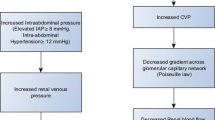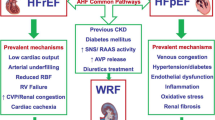Abstract
Purpose of Review
Heart failure with preserved ejection fraction (HFpEF) is a heterogeneous syndrome of exertional intolerance, cardiac dysfunction, and fluid overload and is associated with significant morbidity and mortality.
Recent Findings
As our understanding of this syndrome has evolved, we are beginning to recognize the similarities and associations with chronic kidney disease (CKD). Salt and fluid retention are common in CKD and may be the sentinel event leading ultimately to the syndrome of HFpEF. Mechanisms linking both disease states include hypervolemia, inflammation, and endothelial dysfunction, which are also common to comorbidities that drive both HFpEF and CKD.
Summary
In this review, we will discuss recent clinical research focusing on HFpEF, CKD, and comorbidities including hypertension and diabetes mellitus. We will review strategies for volume management and novel therapeutic approaches with new classes of drugs, including sodium-glucose cotransporters and angiotensin receptor/neprilysin inhibitors, which may work through targeting of both the heart and the kidney. Lastly, we emphasize why focusing on the alleviation of factors provoking renal injury and slowing the progression of renal dysfunction may provide the most therapeutic benefit in patients who have been diagnosed with HFpEF.

Similar content being viewed by others
References
Papers of particular interest, published recently, have been highlighted as: • Of importance •• Of major importance
An empirical study of chronic diseases in the United States: a visual analytics approach to public health. [Online]. Available: https://www.ncbi.nlm.nih.gov/pmc/articles/PMC5876976/. Accessed 26 Jul 2019.
Age-adjusted prevalence of CKD stages 1–4. [Online]. Available: https://nccd.cdc.gov/CKD/detail.aspx?Qnum=Q10. Accessed 20 Jul 2019.
•• WRITING COMMITTEE MEMBERS, et al. 2013 ACCF/AHA guideline for the management of heart failure: a report of the American College of Cardiology Foundation/American Heart Association Task Force on practice guidelines. Circulation. 2013;128(16):e240–327. This comprehensive guideline statement covers the management of heart failure.
Chioncel O, Lainscak M, Seferovic PM, Anker SD, Crespo-Leiro MG, Harjola VP, et al. Epidemiology and one-year outcomes in patients with chronic heart failure and preserved, mid-range and reduced ejection fraction: an analysis of the ESC Heart Failure Long-Term Registry. Eur J Heart Fail. 2017;19(12):1574–85.
Differential Clinical Profiles, Exercise Responses, and Outcomes Associated With Existing HFpEF Definitions | Circulation. [Online]. Available: https://www.ahajournals.org/doi/10.1161/CIRCULATIONAHA.118.039136. Accessed 29 Jul 2019.
Shah KS, et al. Heart failure with preserved, borderline, and reduced ejection fraction: 5-year outcomes. J Am Coll Cardiol. 2017;70(20):2476–86.
• Borlaug BA. The pathophysiology of heart failure with preserved ejection fraction. Nat Rev Cardiol. 2014;11(9):507–15. This review article discusses the pathophysiology and hemodynamics seen in HFpEF.
Age-related characteristics and outcomes of patients with heart failure with preserved ejection fraction | JACC: J Am Coll Cardiol [Online]. Available: http://www.onlinejacc.org/content/74/5/601. Accessed 29 Jul 2019.
Reddy YNV, Carter RE, Obokata M, Redfield MM, Borlaug BA. A simple, evidence-based approach to help guide diagnosis of heart failure with preserved ejection fraction. Circulation. 2018;138(9):861–70.
Heart failure in chronic kidney disease: conclusions from a Kidney Disease: Improving Global Outcomes (KDIGO) Controversies Conference - Kidney International. [Online]. Available: https://www.kidney-international.org/article/S0085-2538(19)30276-5/fulltext. Accessed 22 Jul 2019.
Risk factors for heart failure in patients with chronic kidney disease: the CRIC (Chronic Renal Insufficiency Cohort) Study | J Am Heart Assoc. [Online]. Available: https://www.ahajournals.org/doi/10.1161/JAHA.116.005336. Accessed 23 Jul 2019.
Shchekochikhin D, Nikiforova T, Shilova A, Nesterov A, Baturina O, Gognieva D, et al. Evaluation of discriminative capacity of two formulas of CKD-EPI to predict complications after the first episode of heart failure with preserved ejection fraction. Int J Nephrol Renov Dis. 2019;12:113–8.
Löfman I, Szummer K, Dahlström U, Jernberg T, Lund LH. Associations with and prognostic impact of chronic kidney disease in heart failure with preserved, mid-range, and reduced ejection fraction. Eur J Heart Fail. 2017;19(12):1606–14.
Damman K, van Veldhuisen DJ, Navis G, Vaidya VS, Smilde TDJ, Westenbrink BD, et al. Tubular damage in chronic systolic heart failure is associated with reduced survival independent of glomerular filtration rate. Heart. 2010;96(16):1297–302.
Katz DH, Burns JA, Aguilar FG, Beussink L, Shah SJ. Albuminuria is independently associated with cardiac remodeling, abnormal right and left ventricular function, and worse outcomes in heart failure with preserved ejection fraction. JACC Heart Fail. 2014;2(6):586–96.
Paulus WJ, Tschöpe C. A novel paradigm for heart failure with preserved ejection fraction: comorbidities drive myocardial dysfunction and remodeling through coronary microvascular endothelial inflammation. J Am Coll Cardiol. 2013;62(4):263–71.
Agrawal A, Naranjo M, Kanjanahattakij N, Rangaswami J, Gupta S. Cardiorenal syndrome in heart failure with preserved ejection fraction—an under-recognized clinical entity. Heart Fail Rev. 2019;24(4):421–37.
Van Aelst LNL, et al. Acutely decompensated heart failure with preserved and reduced ejection fraction present with comparable haemodynamic congestion. Eur J Heart Fail. 2018;20(4):738–47.
Ter Maaten JM, et al. Connecting heart failure with preserved ejection fraction and renal dysfunction: the role of endothelial dysfunction and inflammation. Eur J Heart Fail. 2016;18(6):588–98.
Fibroblast growth factor-23: what we know, what we don’t know, and what we need to know. - PubMed - NCBI. [Online]. Available: https://www.ncbi.nlm.nih.gov/pubmed/23625971?dopt=Abstract. Accessed 28 Jul 2019.
Progenitor cells and vascular function are impaired in patients with chronic kidney disease. - PubMed - NCBI. [Online]. Available: https://www.ncbi.nlm.nih.gov/pubmed/20083473?dopt=Abstract. Accessed 28 Jul 2019.
Cardiovascular burden associated with uremic toxins in patients with chronic kidney disease. - PubMed - NCBI. [Online]. Available: https://www.ncbi.nlm.nih.gov/pubmed/23941724?dopt=Abstract. Accessed 28 Jul 2019.
Hypertension, obesity, diabetes, and heart failure–free survival | JACC: heart failure. [Online]. Available: http://heartfailure.onlinejacc.org/content/4/12/911.abstract. Accessed 28 Jul 2019.
Recurrent pulmonary oedema in hypertension due to bilateral renal artery stenosis: treatment by angioplasty or surgical revascularisation. - PubMed - NCBI. [Online]. Available: https://www.ncbi.nlm.nih.gov/pubmed/2900930?dopt=Abstract. Accessed 29 Jul 2019.
• Cardiorenal syndrome. - PubMed - NCBI. [Online]. Available: https://www.ncbi.nlm.nih.gov/pubmed/24656104. Accessed 29 Jul 2019. This review discusses the subtypes of cardiorenal syndrome and current management strategies.
Boonman-de Winter LJM, Rutten FH, Cramer MJM, Landman MJ, Liem AH, Rutten GEHM, et al. High prevalence of previously unknown heart failure and left ventricular dysfunction in patients with type 2 diabetes. Diabetologia. 2012;55(8):2154–62.
Antiangiogenic actions of vascular endothelial growth factor-A165b, an inhibitory isoform of vascular endothelial growth factor-A, in human obesity. - PubMed - NCBI. [Online]. Available: https://www.ncbi.nlm.nih.gov/pubmed/25116954. Accessed 29 Jul 2019.
Systemic inflammation is related to coronary microvascular dysfunction in obese patients without obstructive coronary disease. - PubMed - NCBI. [Online]. Available: https://www.ncbi.nlm.nih.gov/pubmed/24548662. Accessed 29 Jul 2019.
Cardiac inflammation contributes to changes in the extracellular matrix in patients with heart failure and normal ejection fraction. - PubMed - NCBI. [Online]. Available: https://www.ncbi.nlm.nih.gov/pubmed/21075869. Accessed 29 Jul 2019.
Uijl A, Koudstaal S, Vaartjes I, Boer JMA, Verschuren WMM, van der Schouw YT, et al. Risk for heart failure: the opportunity for prevention with the American Heart Association’s Life’s simple 7. JACC Heart Fail. 2019;7(8):637–47.
A randomized trial of intensive versus standard blood-pressure control. N Engl J Med. 2015;373(22):2103–16.
McMurray JJV, et al. Angiotensin-neprilysin inhibition versus enalapril in heart failure. N Engl J Med. 2014;371(11):993–1004.
Richard H, et al. Effects of sacubitril/valsartan versus Irbesartan in patients with chronic kidney disease. Circulation. 2018;138(15):1505–14.
Solomon SD, et al. Baseline characteristics of patients with heart failure and preserved ejection fraction in the PARAGON-HF trial. Circ Heart Fail. 2018;11(7):e004962.
Pitt B, Pfeffer MA, Assmann SF, Boineau R, Anand IS, Claggett B, et al. Spironolactone for heart failure with preserved ejection fraction. N Engl J Med. 2014;370(15):1383–92.
Pfeffer MA, Claggett B, Assmann SF, Boineau R, Anand IS, Clausell N, et al. Regional variation in patients and outcomes in the Treatment of Preserved Cardiac Function Heart Failure With an Aldosterone Antagonist (TOPCAT) trial. Circulation. 2015;131(1):34–42.
Beldhuis IE, et al. Efficacy and safety of spironolactone in patients with HFpEF and chronic kidney disease. JACC Heart Fail. 2018;7(1):25–32.
Kalogeropoulos Andreas P, Jincy T, Javed B, Fang James C. Abstract 11286: spironolactone lowers loop diuretic requirements without adversely affecting renal function and electrolyte balance in patients with heart failure and preserved ejection fraction: a TOPCAT trial analysis. Circulation. 2018;138(Suppl_1):A11286.
Selvaraj S, et al. Prognostic value of albuminuria and influence of spironolactone in heart failure with preserved ejection fraction. Circ Heart Fail. 2018;11(11):e005288.
Spironolactone Initiation Registry Randomized Interventional Trial in Heart Failure With Preserved Ejection Fraction - Full Text View - ClinicalTrials.gov. [Online]. Available: https://clinicaltrials.gov/ct2/show/NCT02901184. Accessed 29 Jul 2019.
Wanner C, Inzucchi SE, Lachin JM, Fitchett D, von Eynatten M, Mattheus M, et al. Empagliflozin and progression of kidney disease in type 2 diabetes. N Engl J Med. 2016;375(4):323–34.
Empagliflozin Improves Diastolic Function in a Nondiabetic Rodent Model of Heart Failure With Preserved Ejection Fraction | JACC: Basic to Translational Science. [Online]. Available: http://basictranslational.onlinejacc.org/content/4/1/27.abstract. Accessed 30 Jul 2019.
Kidokoro K, Cherney DZI, Bozovic A, Nagasu H, Satoh M, Kanda E, et al. Evaluation of glomerular hemodynamic function by empagliflozin in diabetic mice using in vivo imaging. Circulation. 2019;140(4):303–15.
Neal B, et al. Canagliflozin and cardiovascular and renal events in type 2 diabetes. N Engl J Med. 2017;377(7):644–57.
Author information
Authors and Affiliations
Corresponding author
Ethics declarations
Conflict of Interest
Dr James Fang served on the Steering Committee for the EVALUATE-HF Trial and as a co-lead investigator for the DELIVER trial.
Dr Shah has no conflicts of interest.
Human and Animal Rights and Informed Consent
This article does not contain any studies with human or animal subjects performed by any of the authors.
Additional information
Publisher’s Note
Springer Nature remains neutral with regard to jurisdictional claims in published maps and institutional affiliations.
This article is part of the Topical Collection on Mechanisms of Hypertension and Target-Organ Damage
Rights and permissions
About this article
Cite this article
Shah, K.S., Fang, J.C. Is Heart Failure with Preserved Ejection Fraction a Kidney Disorder?. Curr Hypertens Rep 21, 86 (2019). https://doi.org/10.1007/s11906-019-0993-0
Published:
DOI: https://doi.org/10.1007/s11906-019-0993-0




